Entrepreneurship and Small Business Management Report: Unit 9
VerifiedAdded on 2021/02/21
|22
|6297
|107
Report
AI Summary
This report provides a comprehensive analysis of entrepreneurship and small business management, examining various types of entrepreneurial ventures, including small businesses, scalable start-ups, large companies, and social enterprises. It explores the similarities and differences between these ventures, highlighting their unique characteristics and objectives. The report also assesses the impact of micro and small businesses on the economy, emphasizing their importance to the growth of the social economy. Furthermore, it delves into the characteristics, traits, and skills that distinguish successful entrepreneurs from other business managers. The report also examines the role of background and experience in fostering or hindering entrepreneurship. The document provides a detailed overview of the subject, supported by relevant examples and data, offering valuable insights into the world of entrepreneurship and small business management. This report is available on Desklib, a platform that offers past papers and solved assignments to students.

UNIT 9
Entrepreneurship and
Small Business
Management
Entrepreneurship and
Small Business
Management
Paraphrase This Document
Need a fresh take? Get an instant paraphrase of this document with our AI Paraphraser
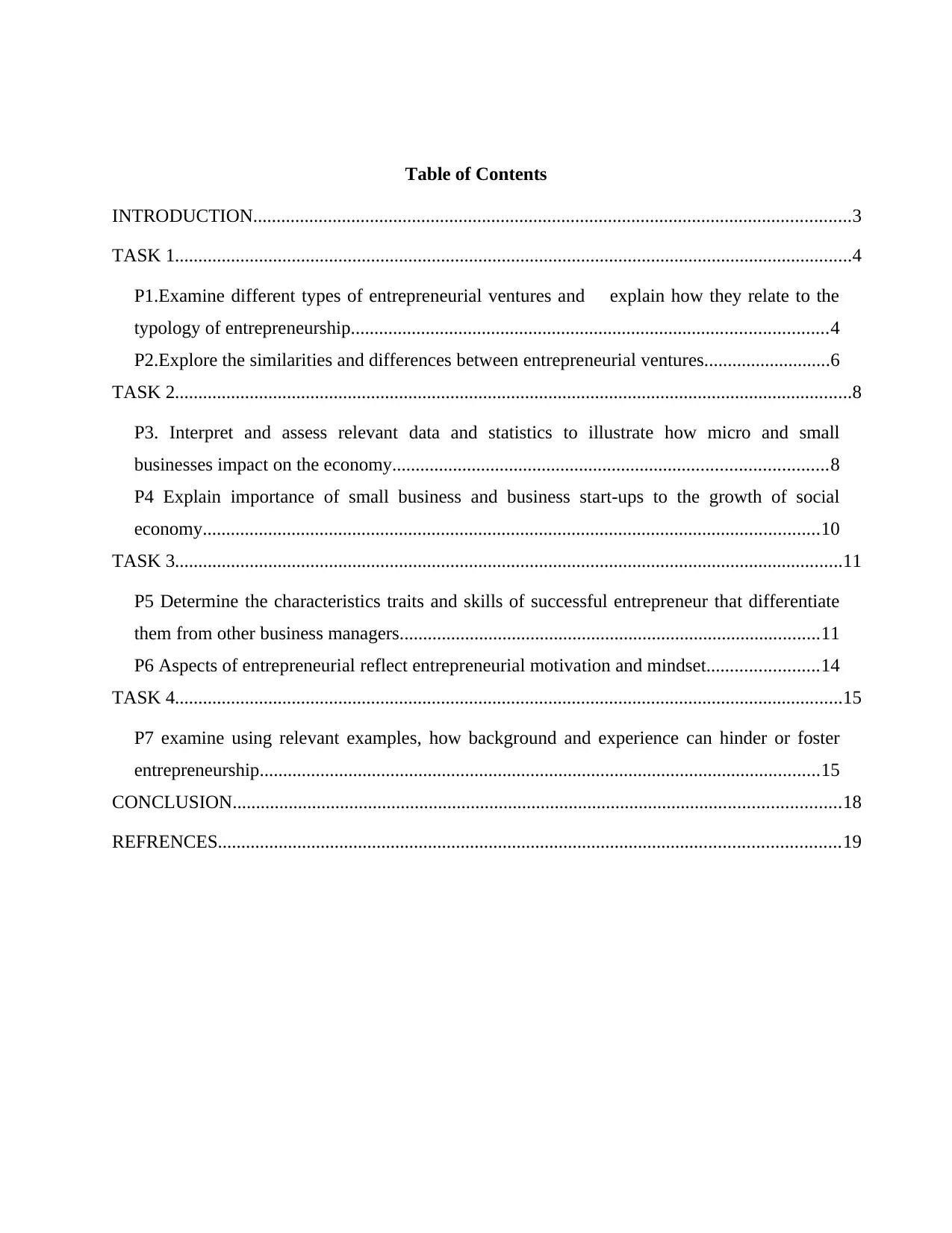
Table of Contents
INTRODUCTION................................................................................................................................3
TASK 1.................................................................................................................................................4
P1.Examine different types of entrepreneurial ventures and explain how they relate to the
typology of entrepreneurship......................................................................................................4
P2.Explore the similarities and differences between entrepreneurial ventures...........................6
TASK 2.................................................................................................................................................8
P3. Interpret and assess relevant data and statistics to illustrate how micro and small
businesses impact on the economy.............................................................................................8
P4 Explain importance of small business and business start-ups to the growth of social
economy....................................................................................................................................10
TASK 3...............................................................................................................................................11
P5 Determine the characteristics traits and skills of successful entrepreneur that differentiate
them from other business managers..........................................................................................11
P6 Aspects of entrepreneurial reflect entrepreneurial motivation and mindset........................14
TASK 4...............................................................................................................................................15
P7 examine using relevant examples, how background and experience can hinder or foster
entrepreneurship........................................................................................................................15
CONCLUSION..................................................................................................................................18
REFRENCES.....................................................................................................................................19
INTRODUCTION................................................................................................................................3
TASK 1.................................................................................................................................................4
P1.Examine different types of entrepreneurial ventures and explain how they relate to the
typology of entrepreneurship......................................................................................................4
P2.Explore the similarities and differences between entrepreneurial ventures...........................6
TASK 2.................................................................................................................................................8
P3. Interpret and assess relevant data and statistics to illustrate how micro and small
businesses impact on the economy.............................................................................................8
P4 Explain importance of small business and business start-ups to the growth of social
economy....................................................................................................................................10
TASK 3...............................................................................................................................................11
P5 Determine the characteristics traits and skills of successful entrepreneur that differentiate
them from other business managers..........................................................................................11
P6 Aspects of entrepreneurial reflect entrepreneurial motivation and mindset........................14
TASK 4...............................................................................................................................................15
P7 examine using relevant examples, how background and experience can hinder or foster
entrepreneurship........................................................................................................................15
CONCLUSION..................................................................................................................................18
REFRENCES.....................................................................................................................................19
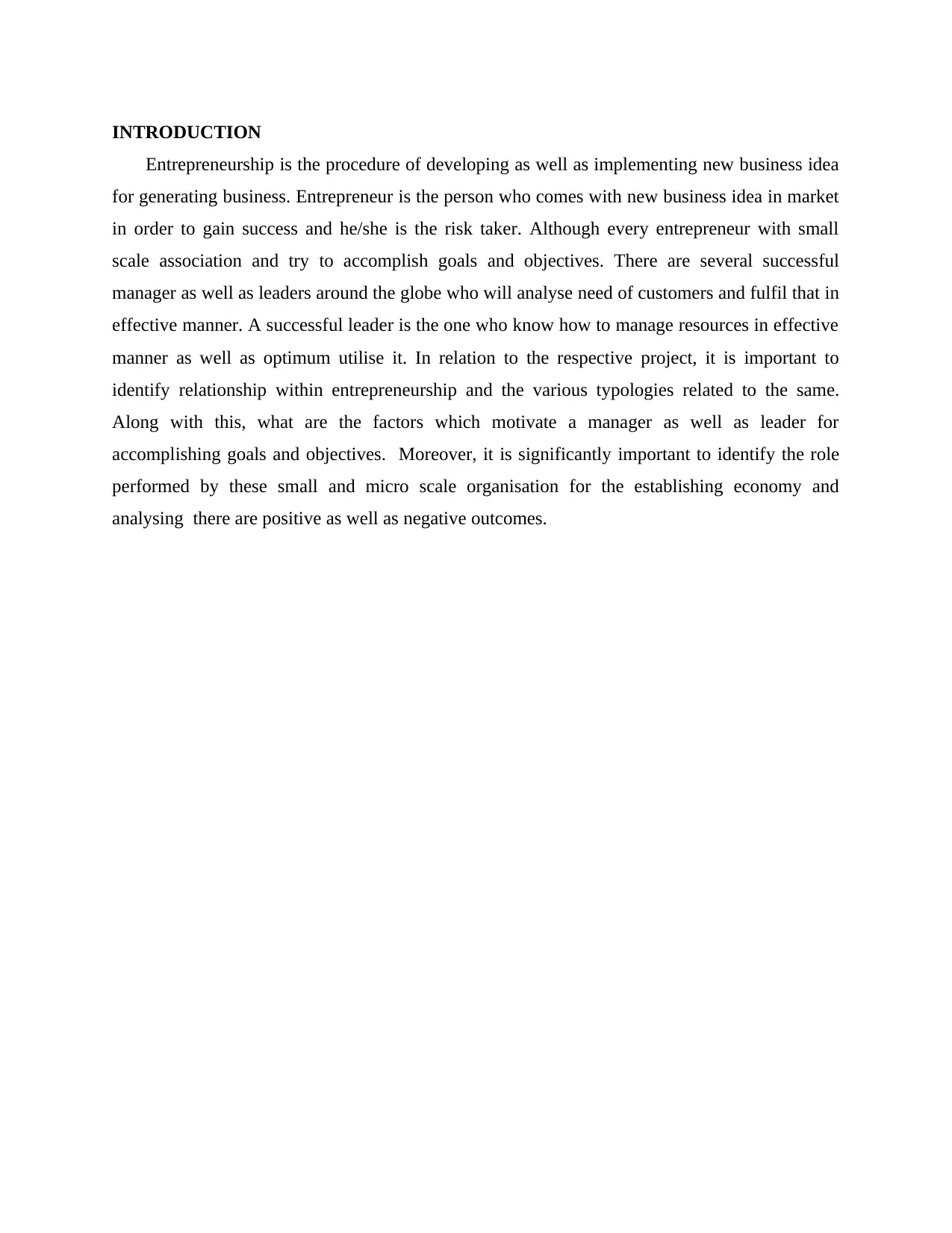
INTRODUCTION
Entrepreneurship is the procedure of developing as well as implementing new business idea
for generating business. Entrepreneur is the person who comes with new business idea in market
in order to gain success and he/she is the risk taker. Although every entrepreneur with small
scale association and try to accomplish goals and objectives. There are several successful
manager as well as leaders around the globe who will analyse need of customers and fulfil that in
effective manner. A successful leader is the one who know how to manage resources in effective
manner as well as optimum utilise it. In relation to the respective project, it is important to
identify relationship within entrepreneurship and the various typologies related to the same.
Along with this, what are the factors which motivate a manager as well as leader for
accomplishing goals and objectives. Moreover, it is significantly important to identify the role
performed by these small and micro scale organisation for the establishing economy and
analysing there are positive as well as negative outcomes.
Entrepreneurship is the procedure of developing as well as implementing new business idea
for generating business. Entrepreneur is the person who comes with new business idea in market
in order to gain success and he/she is the risk taker. Although every entrepreneur with small
scale association and try to accomplish goals and objectives. There are several successful
manager as well as leaders around the globe who will analyse need of customers and fulfil that in
effective manner. A successful leader is the one who know how to manage resources in effective
manner as well as optimum utilise it. In relation to the respective project, it is important to
identify relationship within entrepreneurship and the various typologies related to the same.
Along with this, what are the factors which motivate a manager as well as leader for
accomplishing goals and objectives. Moreover, it is significantly important to identify the role
performed by these small and micro scale organisation for the establishing economy and
analysing there are positive as well as negative outcomes.
⊘ This is a preview!⊘
Do you want full access?
Subscribe today to unlock all pages.

Trusted by 1+ million students worldwide
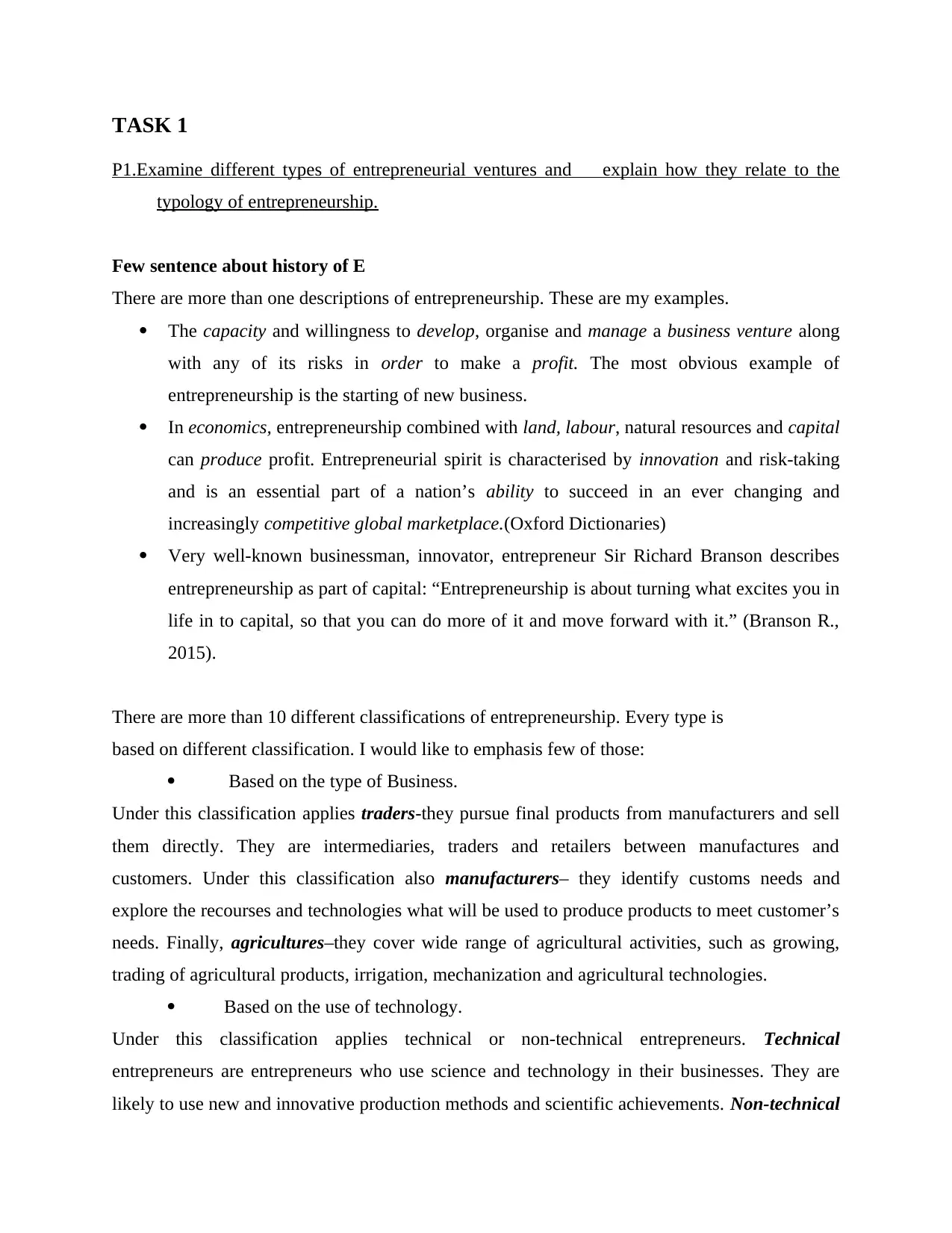
TASK 1
P1.Examine different types of entrepreneurial ventures and explain how they relate to the
typology of entrepreneurship.
Few sentence about history of E
There are more than one descriptions of entrepreneurship. These are my examples.
The capacity and willingness to develop, organise and manage a business venture along
with any of its risks in order to make a profit. The most obvious example of
entrepreneurship is the starting of new business.
In economics, entrepreneurship combined with land, labour, natural resources and capital
can produce profit. Entrepreneurial spirit is characterised by innovation and risk-taking
and is an essential part of a nation’s ability to succeed in an ever changing and
increasingly competitive global marketplace.(Oxford Dictionaries)
Very well-known businessman, innovator, entrepreneur Sir Richard Branson describes
entrepreneurship as part of capital: “Entrepreneurship is about turning what excites you in
life in to capital, so that you can do more of it and move forward with it.” (Branson R.,
2015).
There are more than 10 different classifications of entrepreneurship. Every type is
based on different classification. I would like to emphasis few of those:
Based on the type of Business.
Under this classification applies traders-they pursue final products from manufacturers and sell
them directly. They are intermediaries, traders and retailers between manufactures and
customers. Under this classification also manufacturers– they identify customs needs and
explore the recourses and technologies what will be used to produce products to meet customer’s
needs. Finally, agricultures–they cover wide range of agricultural activities, such as growing,
trading of agricultural products, irrigation, mechanization and agricultural technologies.
Based on the use of technology.
Under this classification applies technical or non-technical entrepreneurs. Technical
entrepreneurs are entrepreneurs who use science and technology in their businesses. They are
likely to use new and innovative production methods and scientific achievements. Non-technical
P1.Examine different types of entrepreneurial ventures and explain how they relate to the
typology of entrepreneurship.
Few sentence about history of E
There are more than one descriptions of entrepreneurship. These are my examples.
The capacity and willingness to develop, organise and manage a business venture along
with any of its risks in order to make a profit. The most obvious example of
entrepreneurship is the starting of new business.
In economics, entrepreneurship combined with land, labour, natural resources and capital
can produce profit. Entrepreneurial spirit is characterised by innovation and risk-taking
and is an essential part of a nation’s ability to succeed in an ever changing and
increasingly competitive global marketplace.(Oxford Dictionaries)
Very well-known businessman, innovator, entrepreneur Sir Richard Branson describes
entrepreneurship as part of capital: “Entrepreneurship is about turning what excites you in
life in to capital, so that you can do more of it and move forward with it.” (Branson R.,
2015).
There are more than 10 different classifications of entrepreneurship. Every type is
based on different classification. I would like to emphasis few of those:
Based on the type of Business.
Under this classification applies traders-they pursue final products from manufacturers and sell
them directly. They are intermediaries, traders and retailers between manufactures and
customers. Under this classification also manufacturers– they identify customs needs and
explore the recourses and technologies what will be used to produce products to meet customer’s
needs. Finally, agricultures–they cover wide range of agricultural activities, such as growing,
trading of agricultural products, irrigation, mechanization and agricultural technologies.
Based on the use of technology.
Under this classification applies technical or non-technical entrepreneurs. Technical
entrepreneurs are entrepreneurs who use science and technology in their businesses. They are
likely to use new and innovative production methods and scientific achievements. Non-technical
Paraphrase This Document
Need a fresh take? Get an instant paraphrase of this document with our AI Paraphraser
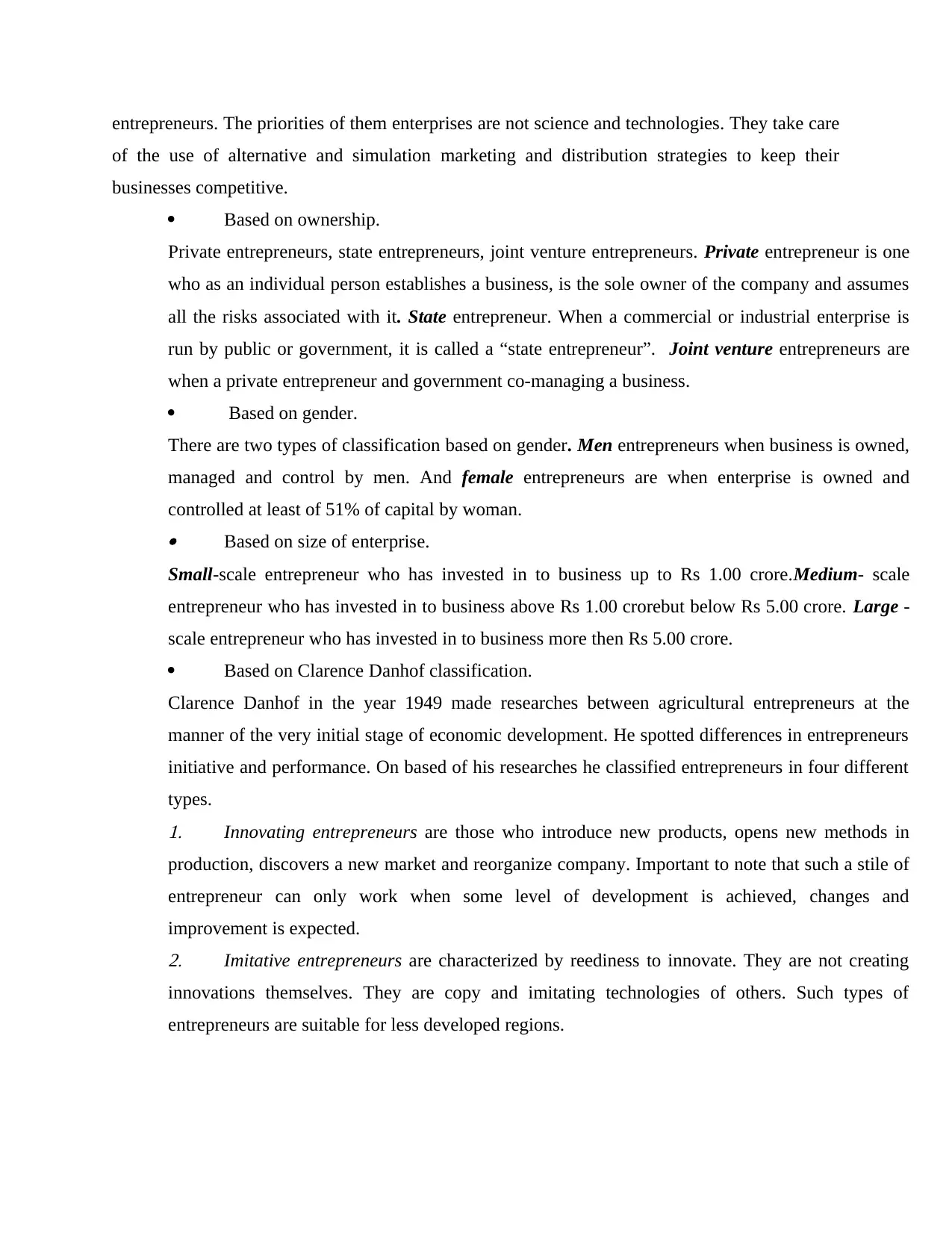
entrepreneurs. The priorities of them enterprises are not science and technologies. They take care
of the use of alternative and simulation marketing and distribution strategies to keep their
businesses competitive.
Based on ownership.
Private entrepreneurs, state entrepreneurs, joint venture entrepreneurs. Private entrepreneur is one
who as an individual person establishes a business, is the sole owner of the company and assumes
all the risks associated with it. State entrepreneur. When a commercial or industrial enterprise is
run by public or government, it is called a “state entrepreneur”. Joint venture entrepreneurs are
when a private entrepreneur and government co-managing a business.
Based on gender.
There are two types of classification based on gender. Men entrepreneurs when business is owned,
managed and control by men. And female entrepreneurs are when enterprise is owned and
controlled at least of 51% of capital by woman.
Based on size of enterprise.
Small-scale entrepreneur who has invested in to business up to Rs 1.00 crore.Medium- scale
entrepreneur who has invested in to business above Rs 1.00 crorebut below Rs 5.00 crore. Large -
scale entrepreneur who has invested in to business more then Rs 5.00 crore.
Based on Clarence Danhof classification.
Clarence Danhof in the year 1949 made researches between agricultural entrepreneurs at the
manner of the very initial stage of economic development. He spotted differences in entrepreneurs
initiative and performance. On based of his researches he classified entrepreneurs in four different
types.
1. Innovating entrepreneurs are those who introduce new products, opens new methods in
production, discovers a new market and reorganize company. Important to note that such a stile of
entrepreneur can only work when some level of development is achieved, changes and
improvement is expected.
2. Imitative entrepreneurs are characterized by reediness to innovate. They are not creating
innovations themselves. They are copy and imitating technologies of others. Such types of
entrepreneurs are suitable for less developed regions.
of the use of alternative and simulation marketing and distribution strategies to keep their
businesses competitive.
Based on ownership.
Private entrepreneurs, state entrepreneurs, joint venture entrepreneurs. Private entrepreneur is one
who as an individual person establishes a business, is the sole owner of the company and assumes
all the risks associated with it. State entrepreneur. When a commercial or industrial enterprise is
run by public or government, it is called a “state entrepreneur”. Joint venture entrepreneurs are
when a private entrepreneur and government co-managing a business.
Based on gender.
There are two types of classification based on gender. Men entrepreneurs when business is owned,
managed and control by men. And female entrepreneurs are when enterprise is owned and
controlled at least of 51% of capital by woman.
Based on size of enterprise.
Small-scale entrepreneur who has invested in to business up to Rs 1.00 crore.Medium- scale
entrepreneur who has invested in to business above Rs 1.00 crorebut below Rs 5.00 crore. Large -
scale entrepreneur who has invested in to business more then Rs 5.00 crore.
Based on Clarence Danhof classification.
Clarence Danhof in the year 1949 made researches between agricultural entrepreneurs at the
manner of the very initial stage of economic development. He spotted differences in entrepreneurs
initiative and performance. On based of his researches he classified entrepreneurs in four different
types.
1. Innovating entrepreneurs are those who introduce new products, opens new methods in
production, discovers a new market and reorganize company. Important to note that such a stile of
entrepreneur can only work when some level of development is achieved, changes and
improvement is expected.
2. Imitative entrepreneurs are characterized by reediness to innovate. They are not creating
innovations themselves. They are copy and imitating technologies of others. Such types of
entrepreneurs are suitable for less developed regions.
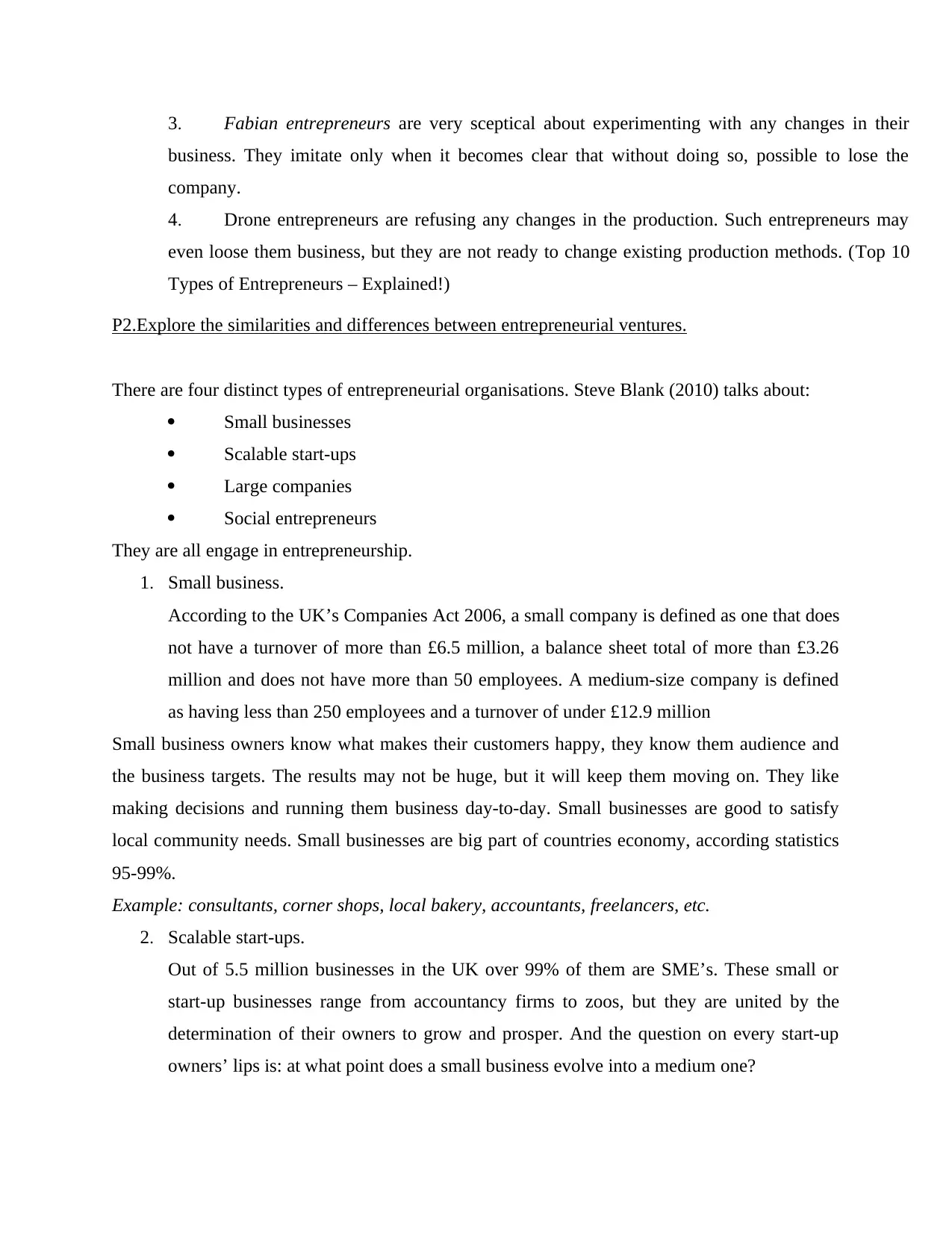
3. Fabian entrepreneurs are very sceptical about experimenting with any changes in their
business. They imitate only when it becomes clear that without doing so, possible to lose the
company.
4. Drone entrepreneurs are refusing any changes in the production. Such entrepreneurs may
even loose them business, but they are not ready to change existing production methods. (Top 10
Types of Entrepreneurs – Explained!)
P2.Explore the similarities and differences between entrepreneurial ventures.
There are four distinct types of entrepreneurial organisations. Steve Blank (2010) talks about:
Small businesses
Scalable start-ups
Large companies
Social entrepreneurs
They are all engage in entrepreneurship.
1. Small business.
According to the UK’s Companies Act 2006, a small company is defined as one that does
not have a turnover of more than £6.5 million, a balance sheet total of more than £3.26
million and does not have more than 50 employees. A medium-size company is defined
as having less than 250 employees and a turnover of under £12.9 million
Small business owners know what makes their customers happy, they know them audience and
the business targets. The results may not be huge, but it will keep them moving on. They like
making decisions and running them business day-to-day. Small businesses are good to satisfy
local community needs. Small businesses are big part of countries economy, according statistics
95-99%.
Example: consultants, corner shops, local bakery, accountants, freelancers, etc.
2. Scalable start-ups.
Out of 5.5 million businesses in the UK over 99% of them are SME’s. These small or
start-up businesses range from accountancy firms to zoos, but they are united by the
determination of their owners to grow and prosper. And the question on every start-up
owners’ lips is: at what point does a small business evolve into a medium one?
business. They imitate only when it becomes clear that without doing so, possible to lose the
company.
4. Drone entrepreneurs are refusing any changes in the production. Such entrepreneurs may
even loose them business, but they are not ready to change existing production methods. (Top 10
Types of Entrepreneurs – Explained!)
P2.Explore the similarities and differences between entrepreneurial ventures.
There are four distinct types of entrepreneurial organisations. Steve Blank (2010) talks about:
Small businesses
Scalable start-ups
Large companies
Social entrepreneurs
They are all engage in entrepreneurship.
1. Small business.
According to the UK’s Companies Act 2006, a small company is defined as one that does
not have a turnover of more than £6.5 million, a balance sheet total of more than £3.26
million and does not have more than 50 employees. A medium-size company is defined
as having less than 250 employees and a turnover of under £12.9 million
Small business owners know what makes their customers happy, they know them audience and
the business targets. The results may not be huge, but it will keep them moving on. They like
making decisions and running them business day-to-day. Small businesses are good to satisfy
local community needs. Small businesses are big part of countries economy, according statistics
95-99%.
Example: consultants, corner shops, local bakery, accountants, freelancers, etc.
2. Scalable start-ups.
Out of 5.5 million businesses in the UK over 99% of them are SME’s. These small or
start-up businesses range from accountancy firms to zoos, but they are united by the
determination of their owners to grow and prosper. And the question on every start-up
owners’ lips is: at what point does a small business evolve into a medium one?
⊘ This is a preview!⊘
Do you want full access?
Subscribe today to unlock all pages.

Trusted by 1+ million students worldwide
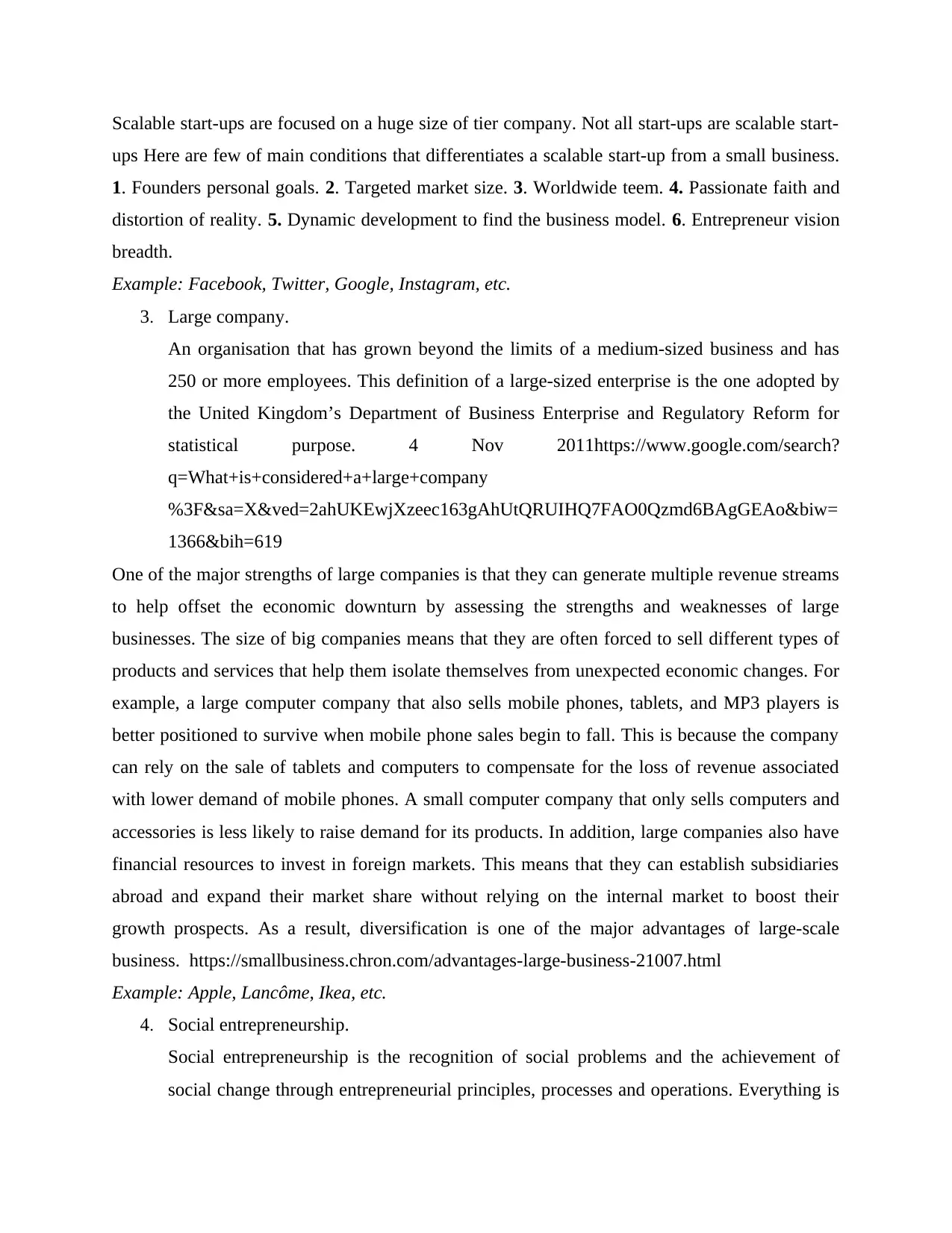
Scalable start-ups are focused on a huge size of tier company. Not all start-ups are scalable start-
ups Here are few of main conditions that differentiates a scalable start-up from a small business.
1. Founders personal goals. 2. Targeted market size. 3. Worldwide teem. 4. Passionate faith and
distortion of reality. 5. Dynamic development to find the business model. 6. Entrepreneur vision
breadth.
Example: Facebook, Twitter, Google, Instagram, etc.
3. Large company.
An organisation that has grown beyond the limits of a medium-sized business and has
250 or more employees. This definition of a large-sized enterprise is the one adopted by
the United Kingdom’s Department of Business Enterprise and Regulatory Reform for
statistical purpose. 4 Nov 2011https://www.google.com/search?
q=What+is+considered+a+large+company
%3F&sa=X&ved=2ahUKEwjXzeec163gAhUtQRUIHQ7FAO0Qzmd6BAgGEAo&biw=
1366&bih=619
One of the major strengths of large companies is that they can generate multiple revenue streams
to help offset the economic downturn by assessing the strengths and weaknesses of large
businesses. The size of big companies means that they are often forced to sell different types of
products and services that help them isolate themselves from unexpected economic changes. For
example, a large computer company that also sells mobile phones, tablets, and MP3 players is
better positioned to survive when mobile phone sales begin to fall. This is because the company
can rely on the sale of tablets and computers to compensate for the loss of revenue associated
with lower demand of mobile phones. A small computer company that only sells computers and
accessories is less likely to raise demand for its products. In addition, large companies also have
financial resources to invest in foreign markets. This means that they can establish subsidiaries
abroad and expand their market share without relying on the internal market to boost their
growth prospects. As a result, diversification is one of the major advantages of large-scale
business. https://smallbusiness.chron.com/advantages-large-business-21007.html
Example: Apple, Lancôme, Ikea, etc.
4. Social entrepreneurship.
Social entrepreneurship is the recognition of social problems and the achievement of
social change through entrepreneurial principles, processes and operations. Everything is
ups Here are few of main conditions that differentiates a scalable start-up from a small business.
1. Founders personal goals. 2. Targeted market size. 3. Worldwide teem. 4. Passionate faith and
distortion of reality. 5. Dynamic development to find the business model. 6. Entrepreneur vision
breadth.
Example: Facebook, Twitter, Google, Instagram, etc.
3. Large company.
An organisation that has grown beyond the limits of a medium-sized business and has
250 or more employees. This definition of a large-sized enterprise is the one adopted by
the United Kingdom’s Department of Business Enterprise and Regulatory Reform for
statistical purpose. 4 Nov 2011https://www.google.com/search?
q=What+is+considered+a+large+company
%3F&sa=X&ved=2ahUKEwjXzeec163gAhUtQRUIHQ7FAO0Qzmd6BAgGEAo&biw=
1366&bih=619
One of the major strengths of large companies is that they can generate multiple revenue streams
to help offset the economic downturn by assessing the strengths and weaknesses of large
businesses. The size of big companies means that they are often forced to sell different types of
products and services that help them isolate themselves from unexpected economic changes. For
example, a large computer company that also sells mobile phones, tablets, and MP3 players is
better positioned to survive when mobile phone sales begin to fall. This is because the company
can rely on the sale of tablets and computers to compensate for the loss of revenue associated
with lower demand of mobile phones. A small computer company that only sells computers and
accessories is less likely to raise demand for its products. In addition, large companies also have
financial resources to invest in foreign markets. This means that they can establish subsidiaries
abroad and expand their market share without relying on the internal market to boost their
growth prospects. As a result, diversification is one of the major advantages of large-scale
business. https://smallbusiness.chron.com/advantages-large-business-21007.html
Example: Apple, Lancôme, Ikea, etc.
4. Social entrepreneurship.
Social entrepreneurship is the recognition of social problems and the achievement of
social change through entrepreneurial principles, processes and operations. Everything is
Paraphrase This Document
Need a fresh take? Get an instant paraphrase of this document with our AI Paraphraser
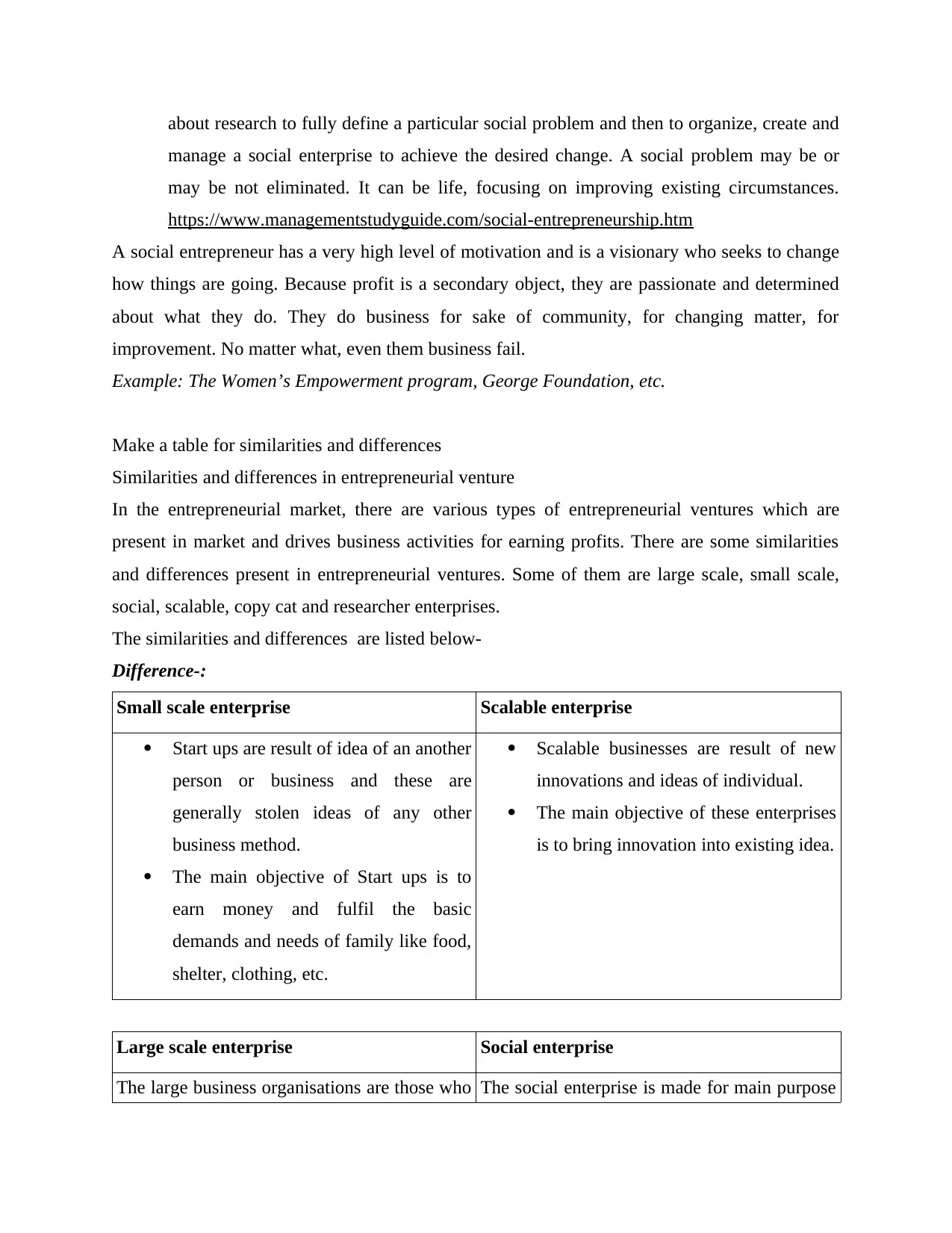
about research to fully define a particular social problem and then to organize, create and
manage a social enterprise to achieve the desired change. A social problem may be or
may be not eliminated. It can be life, focusing on improving existing circumstances.
https://www.managementstudyguide.com/social-entrepreneurship.htm
A social entrepreneur has a very high level of motivation and is a visionary who seeks to change
how things are going. Because profit is a secondary object, they are passionate and determined
about what they do. They do business for sake of community, for changing matter, for
improvement. No matter what, even them business fail.
Example: The Women’s Empowerment program, George Foundation, etc.
Make a table for similarities and differences
Similarities and differences in entrepreneurial venture
In the entrepreneurial market, there are various types of entrepreneurial ventures which are
present in market and drives business activities for earning profits. There are some similarities
and differences present in entrepreneurial ventures. Some of them are large scale, small scale,
social, scalable, copy cat and researcher enterprises.
The similarities and differences are listed below-
Difference-:
Small scale enterprise Scalable enterprise
Start ups are result of idea of an another
person or business and these are
generally stolen ideas of any other
business method.
The main objective of Start ups is to
earn money and fulfil the basic
demands and needs of family like food,
shelter, clothing, etc.
Scalable businesses are result of new
innovations and ideas of individual.
The main objective of these enterprises
is to bring innovation into existing idea.
Large scale enterprise Social enterprise
The large business organisations are those who The social enterprise is made for main purpose
manage a social enterprise to achieve the desired change. A social problem may be or
may be not eliminated. It can be life, focusing on improving existing circumstances.
https://www.managementstudyguide.com/social-entrepreneurship.htm
A social entrepreneur has a very high level of motivation and is a visionary who seeks to change
how things are going. Because profit is a secondary object, they are passionate and determined
about what they do. They do business for sake of community, for changing matter, for
improvement. No matter what, even them business fail.
Example: The Women’s Empowerment program, George Foundation, etc.
Make a table for similarities and differences
Similarities and differences in entrepreneurial venture
In the entrepreneurial market, there are various types of entrepreneurial ventures which are
present in market and drives business activities for earning profits. There are some similarities
and differences present in entrepreneurial ventures. Some of them are large scale, small scale,
social, scalable, copy cat and researcher enterprises.
The similarities and differences are listed below-
Difference-:
Small scale enterprise Scalable enterprise
Start ups are result of idea of an another
person or business and these are
generally stolen ideas of any other
business method.
The main objective of Start ups is to
earn money and fulfil the basic
demands and needs of family like food,
shelter, clothing, etc.
Scalable businesses are result of new
innovations and ideas of individual.
The main objective of these enterprises
is to bring innovation into existing idea.
Large scale enterprise Social enterprise
The large business organisations are those who The social enterprise is made for main purpose
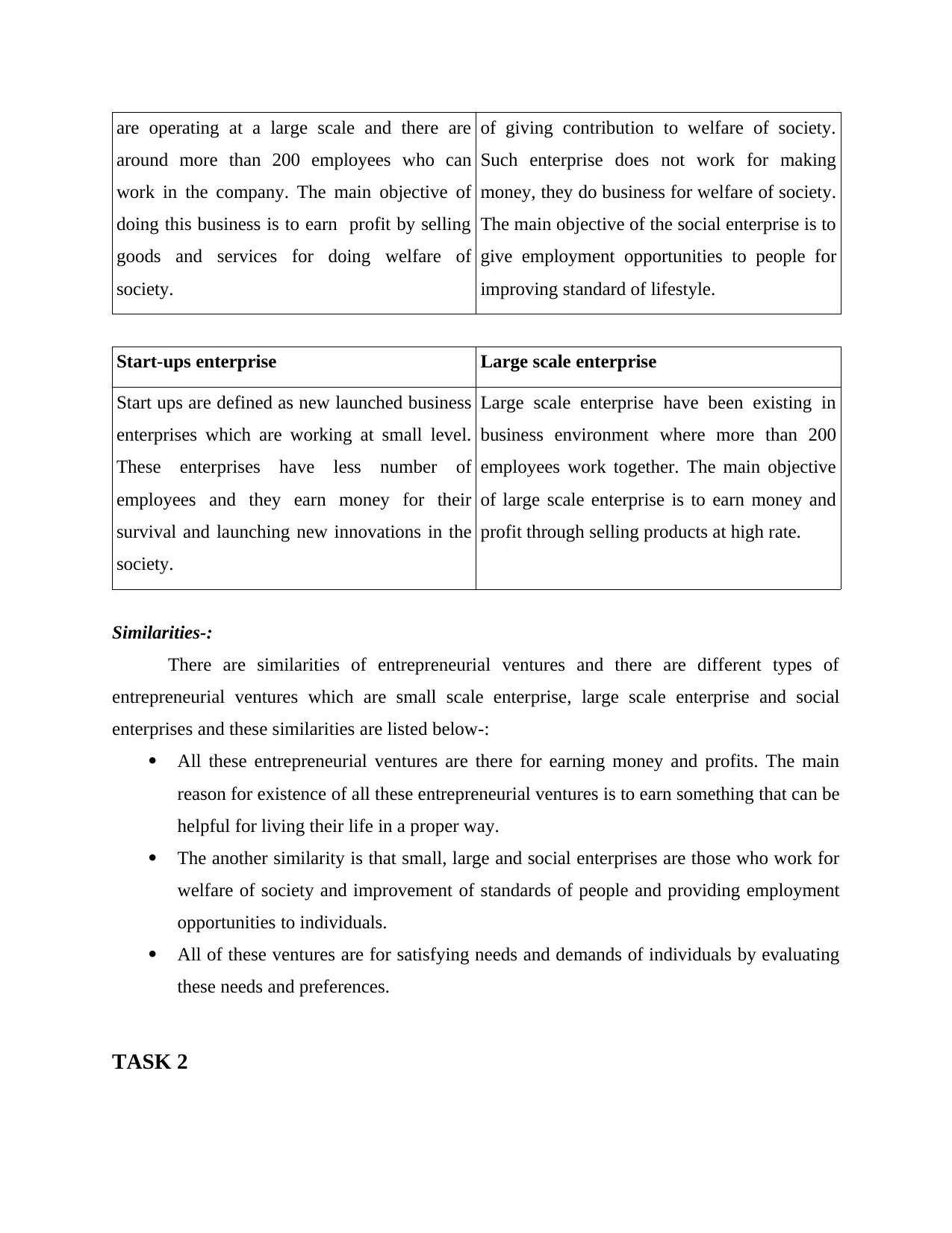
are operating at a large scale and there are
around more than 200 employees who can
work in the company. The main objective of
doing this business is to earn profit by selling
goods and services for doing welfare of
society.
of giving contribution to welfare of society.
Such enterprise does not work for making
money, they do business for welfare of society.
The main objective of the social enterprise is to
give employment opportunities to people for
improving standard of lifestyle.
Start-ups enterprise Large scale enterprise
Start ups are defined as new launched business
enterprises which are working at small level.
These enterprises have less number of
employees and they earn money for their
survival and launching new innovations in the
society.
Large scale enterprise have been existing in
business environment where more than 200
employees work together. The main objective
of large scale enterprise is to earn money and
profit through selling products at high rate.
Similarities-:
There are similarities of entrepreneurial ventures and there are different types of
entrepreneurial ventures which are small scale enterprise, large scale enterprise and social
enterprises and these similarities are listed below-:
All these entrepreneurial ventures are there for earning money and profits. The main
reason for existence of all these entrepreneurial ventures is to earn something that can be
helpful for living their life in a proper way.
The another similarity is that small, large and social enterprises are those who work for
welfare of society and improvement of standards of people and providing employment
opportunities to individuals.
All of these ventures are for satisfying needs and demands of individuals by evaluating
these needs and preferences.
TASK 2
around more than 200 employees who can
work in the company. The main objective of
doing this business is to earn profit by selling
goods and services for doing welfare of
society.
of giving contribution to welfare of society.
Such enterprise does not work for making
money, they do business for welfare of society.
The main objective of the social enterprise is to
give employment opportunities to people for
improving standard of lifestyle.
Start-ups enterprise Large scale enterprise
Start ups are defined as new launched business
enterprises which are working at small level.
These enterprises have less number of
employees and they earn money for their
survival and launching new innovations in the
society.
Large scale enterprise have been existing in
business environment where more than 200
employees work together. The main objective
of large scale enterprise is to earn money and
profit through selling products at high rate.
Similarities-:
There are similarities of entrepreneurial ventures and there are different types of
entrepreneurial ventures which are small scale enterprise, large scale enterprise and social
enterprises and these similarities are listed below-:
All these entrepreneurial ventures are there for earning money and profits. The main
reason for existence of all these entrepreneurial ventures is to earn something that can be
helpful for living their life in a proper way.
The another similarity is that small, large and social enterprises are those who work for
welfare of society and improvement of standards of people and providing employment
opportunities to individuals.
All of these ventures are for satisfying needs and demands of individuals by evaluating
these needs and preferences.
TASK 2
⊘ This is a preview!⊘
Do you want full access?
Subscribe today to unlock all pages.

Trusted by 1+ million students worldwide
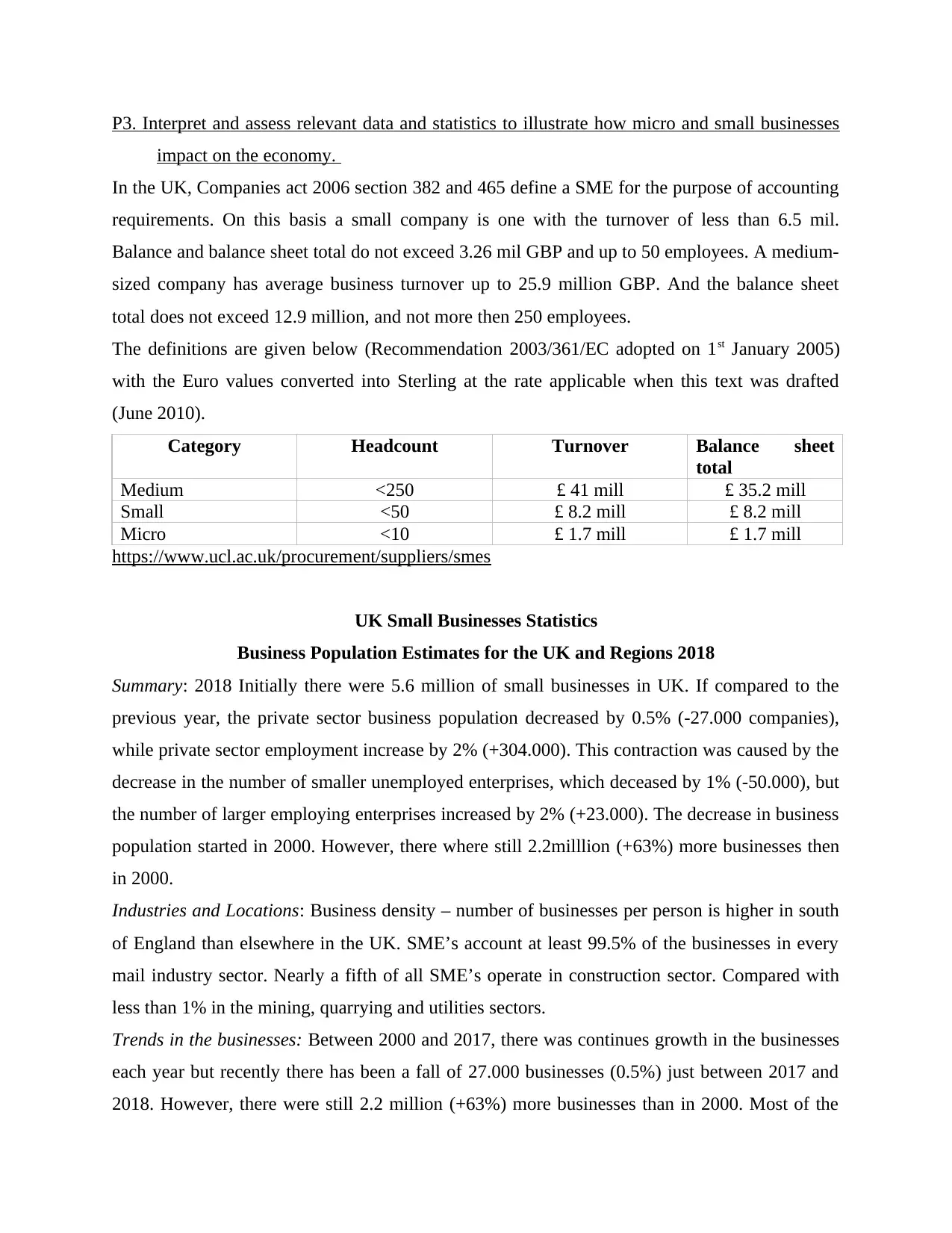
P3. Interpret and assess relevant data and statistics to illustrate how micro and small businesses
impact on the economy.
In the UK, Companies act 2006 section 382 and 465 define a SME for the purpose of accounting
requirements. On this basis a small company is one with the turnover of less than 6.5 mil.
Balance and balance sheet total do not exceed 3.26 mil GBP and up to 50 employees. A medium-
sized company has average business turnover up to 25.9 million GBP. And the balance sheet
total does not exceed 12.9 million, and not more then 250 employees.
The definitions are given below (Recommendation 2003/361/EC adopted on 1st January 2005)
with the Euro values converted into Sterling at the rate applicable when this text was drafted
(June 2010).
Category Headcount Turnover Balance sheet
total
Medium <250 £ 41 mill £ 35.2 mill
Small <50 £ 8.2 mill £ 8.2 mill
Micro <10 £ 1.7 mill £ 1.7 mill
https://www.ucl.ac.uk/procurement/suppliers/smes
UK Small Businesses Statistics
Business Population Estimates for the UK and Regions 2018
Summary: 2018 Initially there were 5.6 million of small businesses in UK. If compared to the
previous year, the private sector business population decreased by 0.5% (-27.000 companies),
while private sector employment increase by 2% (+304.000). This contraction was caused by the
decrease in the number of smaller unemployed enterprises, which deceased by 1% (-50.000), but
the number of larger employing enterprises increased by 2% (+23.000). The decrease in business
population started in 2000. However, there where still 2.2milllion (+63%) more businesses then
in 2000.
Industries and Locations: Business density – number of businesses per person is higher in south
of England than elsewhere in the UK. SME’s account at least 99.5% of the businesses in every
mail industry sector. Nearly a fifth of all SME’s operate in construction sector. Compared with
less than 1% in the mining, quarrying and utilities sectors.
Trends in the businesses: Between 2000 and 2017, there was continues growth in the businesses
each year but recently there has been a fall of 27.000 businesses (0.5%) just between 2017 and
2018. However, there were still 2.2 million (+63%) more businesses than in 2000. Most of the
impact on the economy.
In the UK, Companies act 2006 section 382 and 465 define a SME for the purpose of accounting
requirements. On this basis a small company is one with the turnover of less than 6.5 mil.
Balance and balance sheet total do not exceed 3.26 mil GBP and up to 50 employees. A medium-
sized company has average business turnover up to 25.9 million GBP. And the balance sheet
total does not exceed 12.9 million, and not more then 250 employees.
The definitions are given below (Recommendation 2003/361/EC adopted on 1st January 2005)
with the Euro values converted into Sterling at the rate applicable when this text was drafted
(June 2010).
Category Headcount Turnover Balance sheet
total
Medium <250 £ 41 mill £ 35.2 mill
Small <50 £ 8.2 mill £ 8.2 mill
Micro <10 £ 1.7 mill £ 1.7 mill
https://www.ucl.ac.uk/procurement/suppliers/smes
UK Small Businesses Statistics
Business Population Estimates for the UK and Regions 2018
Summary: 2018 Initially there were 5.6 million of small businesses in UK. If compared to the
previous year, the private sector business population decreased by 0.5% (-27.000 companies),
while private sector employment increase by 2% (+304.000). This contraction was caused by the
decrease in the number of smaller unemployed enterprises, which deceased by 1% (-50.000), but
the number of larger employing enterprises increased by 2% (+23.000). The decrease in business
population started in 2000. However, there where still 2.2milllion (+63%) more businesses then
in 2000.
Industries and Locations: Business density – number of businesses per person is higher in south
of England than elsewhere in the UK. SME’s account at least 99.5% of the businesses in every
mail industry sector. Nearly a fifth of all SME’s operate in construction sector. Compared with
less than 1% in the mining, quarrying and utilities sectors.
Trends in the businesses: Between 2000 and 2017, there was continues growth in the businesses
each year but recently there has been a fall of 27.000 businesses (0.5%) just between 2017 and
2018. However, there were still 2.2 million (+63%) more businesses than in 2000. Most of the
Paraphrase This Document
Need a fresh take? Get an instant paraphrase of this document with our AI Paraphraser
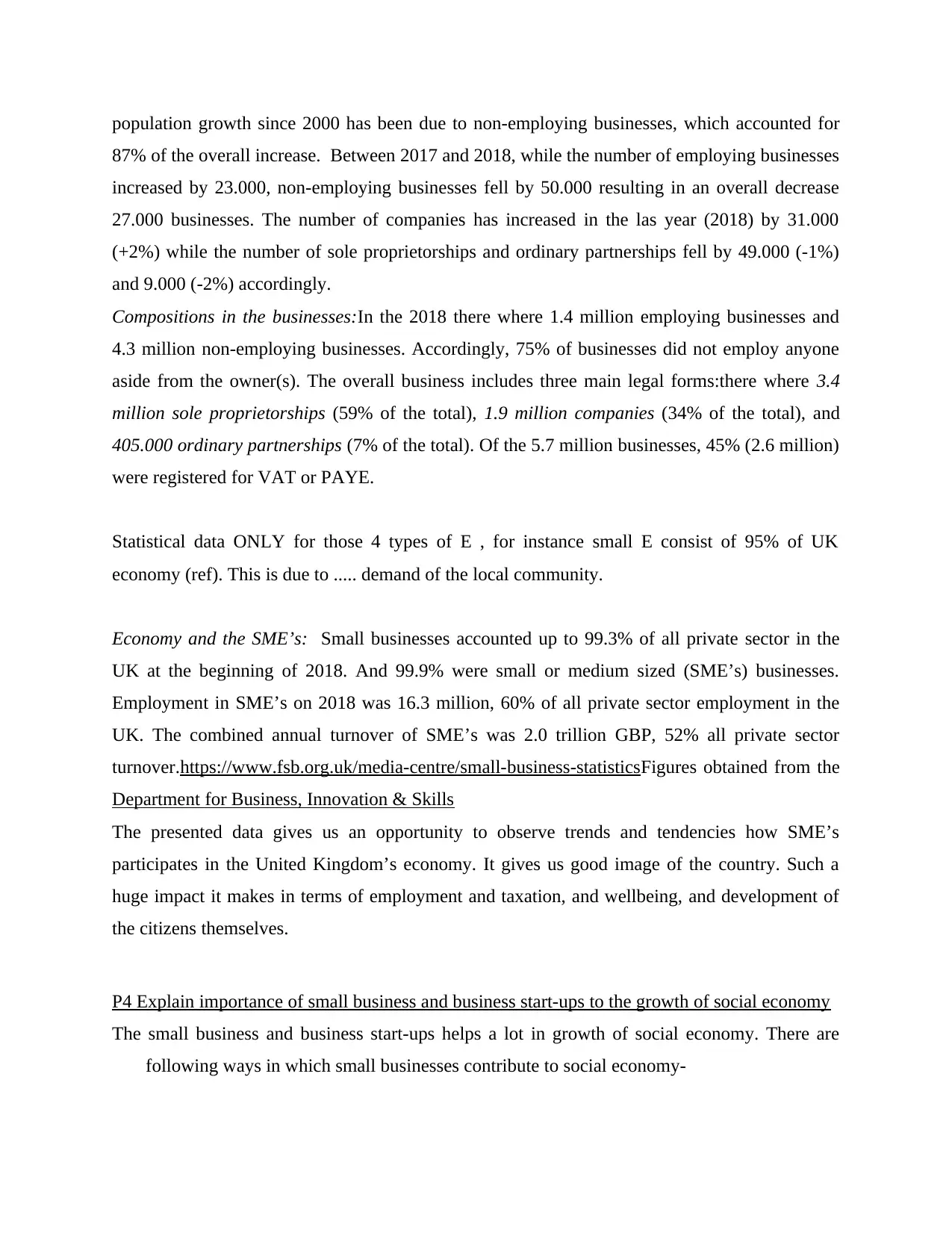
population growth since 2000 has been due to non-employing businesses, which accounted for
87% of the overall increase. Between 2017 and 2018, while the number of employing businesses
increased by 23.000, non-employing businesses fell by 50.000 resulting in an overall decrease
27.000 businesses. The number of companies has increased in the las year (2018) by 31.000
(+2%) while the number of sole proprietorships and ordinary partnerships fell by 49.000 (-1%)
and 9.000 (-2%) accordingly.
Compositions in the businesses:In the 2018 there where 1.4 million employing businesses and
4.3 million non-employing businesses. Accordingly, 75% of businesses did not employ anyone
aside from the owner(s). The overall business includes three main legal forms:there where 3.4
million sole proprietorships (59% of the total), 1.9 million companies (34% of the total), and
405.000 ordinary partnerships (7% of the total). Of the 5.7 million businesses, 45% (2.6 million)
were registered for VAT or PAYE.
Statistical data ONLY for those 4 types of E , for instance small E consist of 95% of UK
economy (ref). This is due to ..... demand of the local community.
Economy and the SME’s: Small businesses accounted up to 99.3% of all private sector in the
UK at the beginning of 2018. And 99.9% were small or medium sized (SME’s) businesses.
Employment in SME’s on 2018 was 16.3 million, 60% of all private sector employment in the
UK. The combined annual turnover of SME’s was 2.0 trillion GBP, 52% all private sector
turnover.https://www.fsb.org.uk/media-centre/small-business-statisticsFigures obtained from the
Department for Business, Innovation & Skills
The presented data gives us an opportunity to observe trends and tendencies how SME’s
participates in the United Kingdom’s economy. It gives us good image of the country. Such a
huge impact it makes in terms of employment and taxation, and wellbeing, and development of
the citizens themselves.
P4 Explain importance of small business and business start-ups to the growth of social economy
The small business and business start-ups helps a lot in growth of social economy. There are
following ways in which small businesses contribute to social economy-
87% of the overall increase. Between 2017 and 2018, while the number of employing businesses
increased by 23.000, non-employing businesses fell by 50.000 resulting in an overall decrease
27.000 businesses. The number of companies has increased in the las year (2018) by 31.000
(+2%) while the number of sole proprietorships and ordinary partnerships fell by 49.000 (-1%)
and 9.000 (-2%) accordingly.
Compositions in the businesses:In the 2018 there where 1.4 million employing businesses and
4.3 million non-employing businesses. Accordingly, 75% of businesses did not employ anyone
aside from the owner(s). The overall business includes three main legal forms:there where 3.4
million sole proprietorships (59% of the total), 1.9 million companies (34% of the total), and
405.000 ordinary partnerships (7% of the total). Of the 5.7 million businesses, 45% (2.6 million)
were registered for VAT or PAYE.
Statistical data ONLY for those 4 types of E , for instance small E consist of 95% of UK
economy (ref). This is due to ..... demand of the local community.
Economy and the SME’s: Small businesses accounted up to 99.3% of all private sector in the
UK at the beginning of 2018. And 99.9% were small or medium sized (SME’s) businesses.
Employment in SME’s on 2018 was 16.3 million, 60% of all private sector employment in the
UK. The combined annual turnover of SME’s was 2.0 trillion GBP, 52% all private sector
turnover.https://www.fsb.org.uk/media-centre/small-business-statisticsFigures obtained from the
Department for Business, Innovation & Skills
The presented data gives us an opportunity to observe trends and tendencies how SME’s
participates in the United Kingdom’s economy. It gives us good image of the country. Such a
huge impact it makes in terms of employment and taxation, and wellbeing, and development of
the citizens themselves.
P4 Explain importance of small business and business start-ups to the growth of social economy
The small business and business start-ups helps a lot in growth of social economy. There are
following ways in which small businesses contribute to social economy-
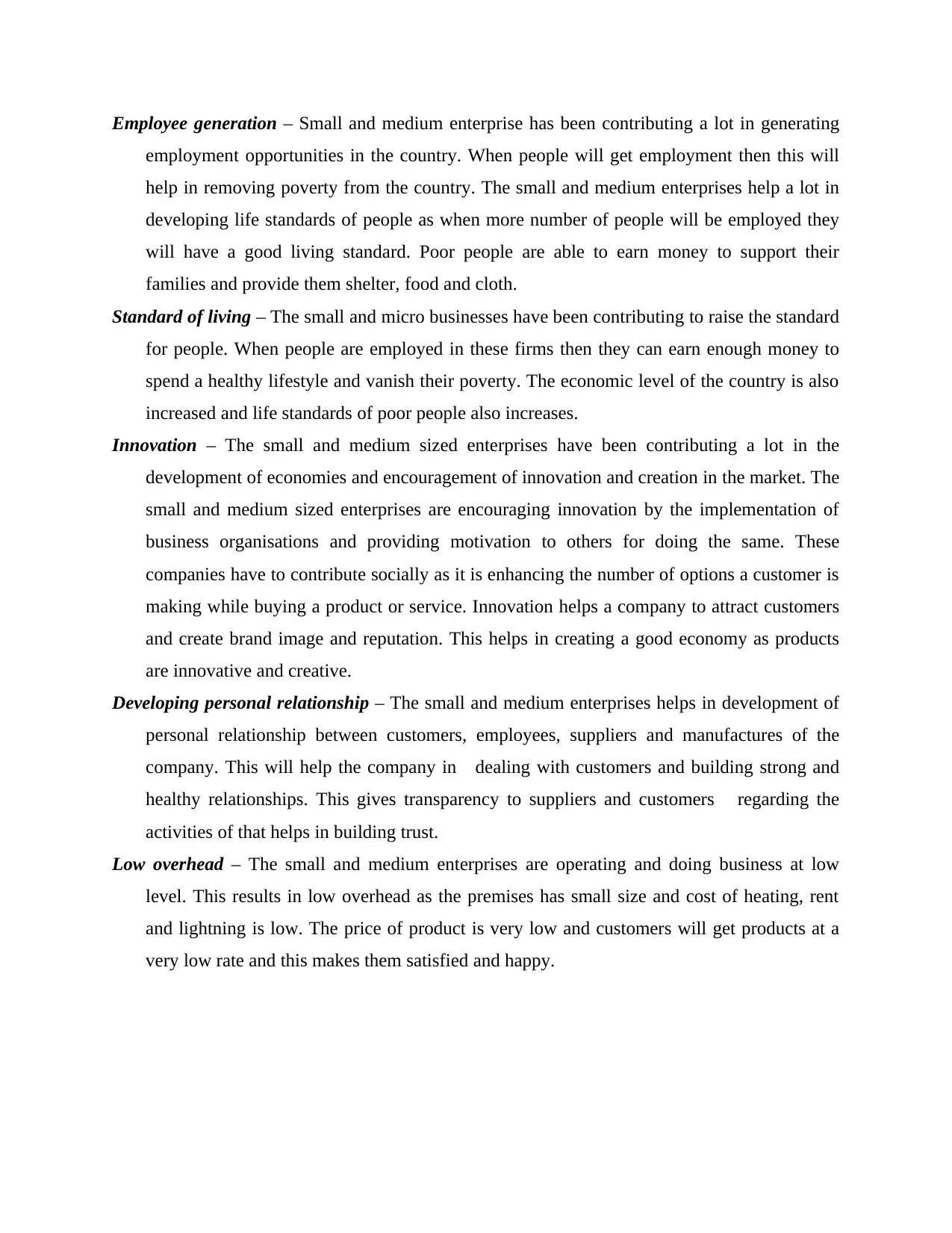
Employee generation – Small and medium enterprise has been contributing a lot in generating
employment opportunities in the country. When people will get employment then this will
help in removing poverty from the country. The small and medium enterprises help a lot in
developing life standards of people as when more number of people will be employed they
will have a good living standard. Poor people are able to earn money to support their
families and provide them shelter, food and cloth.
Standard of living – The small and micro businesses have been contributing to raise the standard
for people. When people are employed in these firms then they can earn enough money to
spend a healthy lifestyle and vanish their poverty. The economic level of the country is also
increased and life standards of poor people also increases.
Innovation – The small and medium sized enterprises have been contributing a lot in the
development of economies and encouragement of innovation and creation in the market. The
small and medium sized enterprises are encouraging innovation by the implementation of
business organisations and providing motivation to others for doing the same. These
companies have to contribute socially as it is enhancing the number of options a customer is
making while buying a product or service. Innovation helps a company to attract customers
and create brand image and reputation. This helps in creating a good economy as products
are innovative and creative.
Developing personal relationship – The small and medium enterprises helps in development of
personal relationship between customers, employees, suppliers and manufactures of the
company. This will help the company in dealing with customers and building strong and
healthy relationships. This gives transparency to suppliers and customers regarding the
activities of that helps in building trust.
Low overhead – The small and medium enterprises are operating and doing business at low
level. This results in low overhead as the premises has small size and cost of heating, rent
and lightning is low. The price of product is very low and customers will get products at a
very low rate and this makes them satisfied and happy.
employment opportunities in the country. When people will get employment then this will
help in removing poverty from the country. The small and medium enterprises help a lot in
developing life standards of people as when more number of people will be employed they
will have a good living standard. Poor people are able to earn money to support their
families and provide them shelter, food and cloth.
Standard of living – The small and micro businesses have been contributing to raise the standard
for people. When people are employed in these firms then they can earn enough money to
spend a healthy lifestyle and vanish their poverty. The economic level of the country is also
increased and life standards of poor people also increases.
Innovation – The small and medium sized enterprises have been contributing a lot in the
development of economies and encouragement of innovation and creation in the market. The
small and medium sized enterprises are encouraging innovation by the implementation of
business organisations and providing motivation to others for doing the same. These
companies have to contribute socially as it is enhancing the number of options a customer is
making while buying a product or service. Innovation helps a company to attract customers
and create brand image and reputation. This helps in creating a good economy as products
are innovative and creative.
Developing personal relationship – The small and medium enterprises helps in development of
personal relationship between customers, employees, suppliers and manufactures of the
company. This will help the company in dealing with customers and building strong and
healthy relationships. This gives transparency to suppliers and customers regarding the
activities of that helps in building trust.
Low overhead – The small and medium enterprises are operating and doing business at low
level. This results in low overhead as the premises has small size and cost of heating, rent
and lightning is low. The price of product is very low and customers will get products at a
very low rate and this makes them satisfied and happy.
⊘ This is a preview!⊘
Do you want full access?
Subscribe today to unlock all pages.

Trusted by 1+ million students worldwide
1 out of 22
Related Documents
Your All-in-One AI-Powered Toolkit for Academic Success.
+13062052269
info@desklib.com
Available 24*7 on WhatsApp / Email
![[object Object]](/_next/static/media/star-bottom.7253800d.svg)
Unlock your academic potential
Copyright © 2020–2025 A2Z Services. All Rights Reserved. Developed and managed by ZUCOL.




